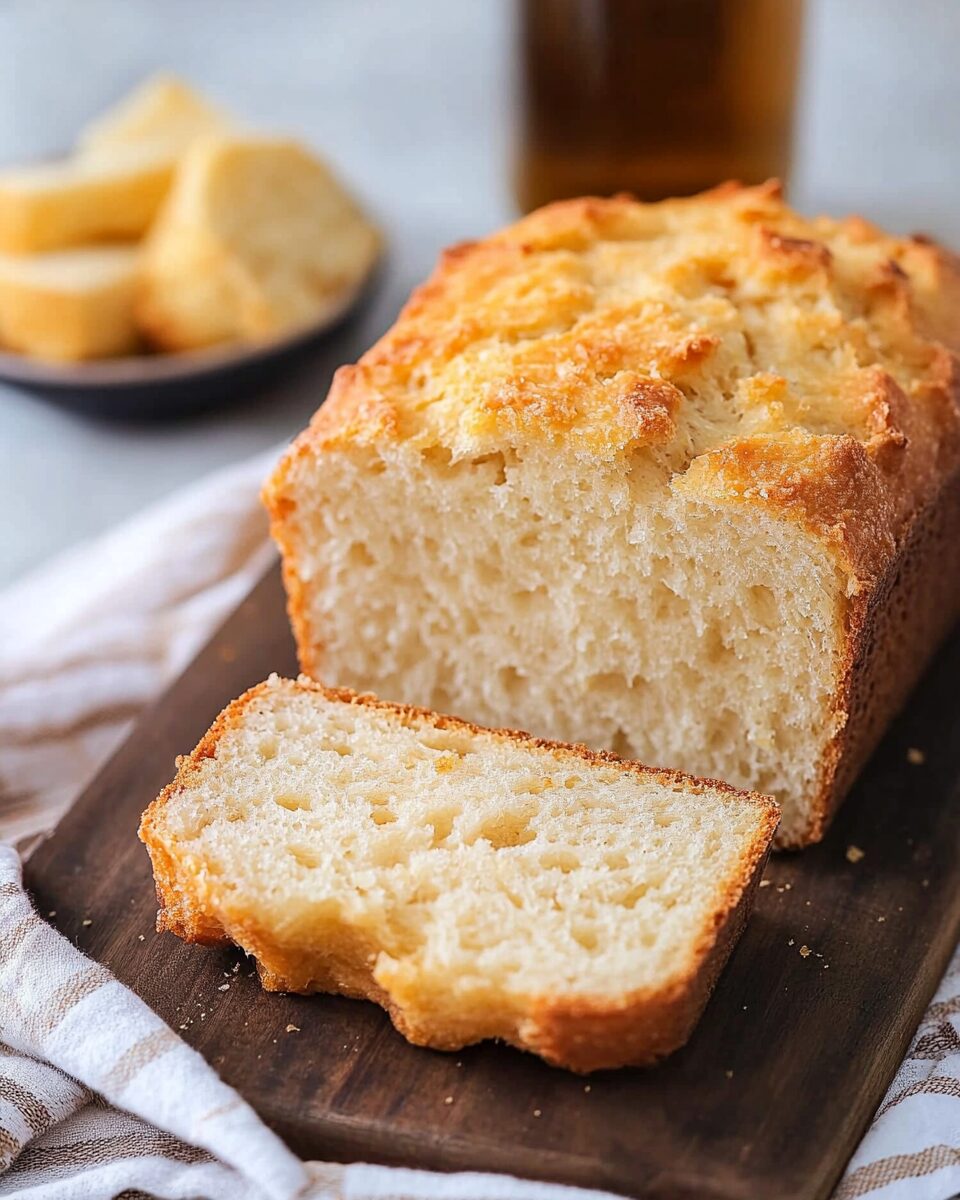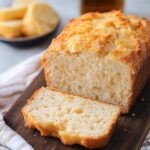The rich, yeasty aroma of beer blends beautifully with simple pantry ingredients to create a rustic, golden loaf that’s crisp on the outside and tender within. With no kneading or yeast required, this beer bread is as close to instant gratification as homemade bread can get.
Whether you’re pairing it with a hearty stew, serving it alongside a summer barbecue, or just enjoying it warm with a swipe of butter, this bread is a show-stopper. Its buttery crust, quick preparation, and endlessly adaptable base make it a staple for beginner bakers and seasoned pros alike.
Full Recipe
Ingredients:
-
3 cups all-purpose flour
-
3 teaspoons baking powder
-
1 teaspoon salt
-
1/4 cup granulated sugar
-
1 (12 oz) can of beer
-
1/2 cup (1 stick) unsalted butter, melted
Directions:
-
Preheat oven to 375°F (190°C). Grease a 9×5-inch loaf pan.
-
In a large mixing bowl, whisk together flour, baking powder, salt, and sugar.
-
Pour the beer into the dry ingredients and mix until just combined.
-
Spoon the dough into the prepared pan and spread it out evenly.
-
Pour melted butter over the top of the dough.
-
Bake for 45–55 minutes or until golden brown on top and a toothpick inserted in the center comes out clean.
-
Let cool in the pan for 10 minutes, then transfer to a wire rack to cool completely. Slice and serve.
Prep Time: 5 minutes | Cooking Time: 50 minutes | Total Time: 55 minutes
Kcal: 210 kcal | Servings: 10 slices
What Makes Beer Bread So Special
Beer bread is one of those rare recipes that manages to feel both rustic and indulgent while requiring almost no culinary expertise. With a foundation of simple pantry ingredients—flour, sugar, salt, baking powder, and beer—this bread delivers exceptional flavor and texture without any need for yeast or long proofing times. Its appeal lies in its versatility, speed, and the magical way beer adds complexity to something so basic. From casual dinners to cozy gatherings, this bread never feels out of place and always disappears fast from the table.
The characteristic crust of beer bread is golden, rich, and crisp, thanks to the final pour of melted butter over the top before baking. This helps create a deliciously buttery finish that contrasts perfectly with the soft, moist crumb inside. It’s this combination of textures, paired with a subtle hoppy undertone from the beer, that makes it truly addictive.
Why Beer Bread Works Without Yeast
Traditional bread recipes rely on yeast as a leavening agent to create rise and airiness. Beer bread, however, bypasses this entirely by using the carbonation and fermentation from beer in combination with baking powder. The bubbles in the beer and the leavening action of baking powder create a perfectly risen loaf without the need for proofing. It’s essentially a quick bread—similar in style to banana bread or zucchini bread—but savory instead of sweet.
The alcohol content in the beer cooks off during baking, but the malty, slightly bitter flavors remain, lending depth to the final product. This means you get complex flavor notes without the effort that usually goes into artisan-style bread.
The Role of Butter in Beer Bread
While the dough itself is not enriched with butter, pouring melted butter on top of the dough before baking does something magical. It seeps into the cracks and edges, crisping the crust and giving each slice a delicious, rich edge. The butter also helps to seal in moisture, so the bread stays tender longer than typical quick breads.
This technique results in a loaf that feels hearty and decadent without being heavy. You can even experiment with herb- or garlic-infused butter to elevate the flavor even further.
Choosing the Right Beer for Beer Bread
One of the best aspects of beer bread is how customizable it is. The flavor of your bread will change depending on the type of beer you use. A light lager or pilsner results in a milder, slightly sweet bread, while an IPA or darker ale will yield a stronger, maltier flavor with subtle bitterness.
For those who prefer a sweeter profile, a wheat beer or amber ale might be ideal. On the other hand, using a stout or porter will produce a richer, almost chocolatey loaf—excellent for serving with chili or a robust beef stew. If you’re cooking for kids or avoiding alcohol entirely, non-alcoholic beer works just as well and still provides that essential carbonation needed to help the bread rise.
When and How to Serve Beer Bread
Beer bread shines in nearly any meal setting. It’s a perfect companion to soups and stews, ideal for dunking into creamy chowders or spicy chili. Its hearty structure means it holds up well to bold flavors, making it a great base for open-faced sandwiches or even grilled cheese.
You can also slice it thin, toast it, and serve with spreads like whipped goat cheese, herb butter, or even hummus. For breakfast or brunch, try it alongside eggs and sausage for a slightly savory twist. It’s also a popular choice on charcuterie boards—especially when served warm with honey or spicy jam.
Tips for Perfecting Your Beer Bread
While beer bread is delightfully simple, there are a few tips that can elevate your loaf from good to great:
-
Don’t overmix the dough: Like all quick breads, too much mixing can lead to a tough texture. Stir until just combined.
-
Use room temperature beer: Cold beer can seize up the melted butter and affect the texture of the dough.
-
Line your pan with parchment paper: This makes it easier to lift out the loaf without damaging the crispy crust.
-
Add extras for variety: Shredded cheese, garlic powder, chopped herbs, or even jalapeños can be folded into the dough for added flair.
Adaptations and Variations
This base recipe is a canvas for creativity. You can add chopped green onions and cheddar for a savory cheddar beer loaf. Try adding a swirl of honey for a subtly sweet version, or chopped nuts for texture. For a more robust flavor, add a pinch of smoked paprika or some freshly cracked black pepper to the dough.
Some bakers even make mini loaves or muffins from the same batter to serve at parties or alongside a holiday roast. And because the recipe is egg-free, it’s a reliable option for guests with allergies.
Health and Nutritional Notes
While beer bread isn’t a health food by any stretch, it’s a more wholesome option than many processed breads. You know exactly what’s going in—no preservatives, artificial colors, or unnecessary additives. You can also use whole wheat flour or a mix of flours for added fiber and nutrition.
When enjoyed in moderation, this bread provides a good source of carbohydrates and pairs well with protein-rich mains and fiber-filled vegetables. It’s also relatively low in sugar compared to many store-bought options.
Storing and Freezing Beer Bread
Beer bread stores well on the counter for up to 2 days when wrapped tightly in foil or kept in an airtight container. For longer storage, refrigerate it for up to 5 days, or slice and freeze it for up to 3 months. Just pop a frozen slice in the toaster for a quick and satisfying snack or side.
Why This Recipe Is a Must-Have
This beer bread recipe is beloved for a reason—it’s reliable, fast, and produces incredible flavor with minimal effort. Whether you’re baking for a crowd or just want something warm and homemade to go with your meal, it checks every box. It doesn’t demand advanced baking skills or fancy equipment—just a bowl, a spoon, and your favorite beer.
It’s also a great recipe for involving kids or beginners in the kitchen. With no kneading, rising, or shaping required, it’s almost impossible to mess up. Yet the results feel gourmet, thanks to the complexity of the beer and the richness of the buttery crust.
Conclusion
Beer bread is the kind of comfort food that’s deceptively simple yet endlessly satisfying. It’s rooted in tradition but flexible enough for modern tastes. Whether you keep it classic or add your own twist, the result is always delicious—a crusty, buttery, flavorful loaf that pairs with just about anything.
Its no-fuss preparation and crowd-pleasing taste make it a go-to recipe for weeknights, holidays, and everything in between. If you’ve never made homemade bread before, this is the perfect place to start. And once you try it, you’ll wonder how your table ever went without it.






